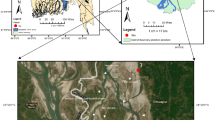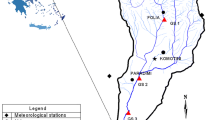Abstract
Water quality indices (WQIs) have been developed to assess the suitability of water for a variety of uses. These indices reflect the status of water quality in lakes, streams, rivers, and reservoirs. The concept of WQIs is based on a comparison of the concentration of contaminants with the respective environmental standards. The number, frequency, and magnitude by which the environmental standards for specific variables are not met in a given time period are reflected in WQIs. Further, the water quality trend analysis predicts the behavior of the water quality parameters and overall water quality in the time domain. In this paper, the concept of WQI was applied to three selected watersheds of Atlantic region: the Mersey River, the Point Wolfe River, and the Dunk River sites. To have robust study, two different water quality indices are used: Canadian Water Quality Index (CWQI), and British Columbia Water Quality Index (BWQI). The complete study was conducted in two steps. The first step was to organize and process the data into a format compatible with WQI analysis. After processing the input data, the WQI was calculated. The second step outlined in the paper discusses detailed trend analysis using linear and quadratic models for all the three sites. As per the 25 years trend analysis, overall water quality for agriculture use observed an improving trend at all the three sites studied. Water quality for raw water used for drinking (prior to treatment) and aquatic uses has shown improving trend at Point Wolfe River. It is further observed that pH, SO4, and NO3 concentrations are improving at Dunk River, Mersey River, and Point Wolfe River sites. To ascertain the reliability and significance of the trend analysis, a detailed error analysis and parametric significance tests were also conducted It was observed that for most of the sites and water uses quadratic trend models were a better fit than the linear models.
Similar content being viewed by others
References
Bhargava, D. S.: 1985, ‘Expression for drinking water supply standards’, J. Environ. Engin., ASCE 106(4), 757–771.
CCME: 1999, Canadian Environmental Qualities Guidelines, Canadian Council of Ministers of the environment, Manitoba Statuary Publications, Winnipeg, Canada, Updated in 2000.
Dinius, S. H.: 1987, ‘Design of an index of water quality’ Water Resource Bull. 23(5), 833.
Hart, W.: 1998, ‘Alternative Formulations of Factors Used in the British Columbia Water Quality Index’. Report submitted to the Technical Subcommittee of the CCME Water Quality Guidelines Task Group.
Husain, T.: 1998, ‘Application of National Water Quality Index Prototype in Newfoundland’, The State of Environment Reporting Task Group, The Canadian Council of Ministers of the Environment.
Husain, T., Khan, A. A. and Mukhtasor, A.: 1999, ‘Final Report on Water Quality Index for Northwest Territories’, Water Management Planning Section, Yellowknife, pp. 12–13.
Husain, T.: 2001, ‘Canadian Water Quality Index Determination for three EMAN Sites’, Ecological Monitoring and Assessment Network (EMAN), Environment Canada, Burlington, ON.
Landwehr, J. M.: 1979, ‘A statistical view of a class of water quality indices’, Water Resource Res. 15(2), 460–468.
Phippen, B.: 1998, ‘Application of the National Water Quality Index Prototype in British Columbia’. BWP Consulting, 60 pp. June, 1998.
Rocchini, R., Swain, L. G.: 1995, ‘The British Columbia Water Quality Index’. Water Quality Branch, Environmental Protection Department, British Columbia Ministry of Environment, Land and Parks. 13 pp.
Smith, D. G.: 1990, ‘A Better Water Quality Indexing System for Rivers and Streams’. Water Res. 24(10), 1237–1244.
Swamee, P. K. and Tyagi, A.: 2000, ‘Describing water quality with aggregate index’, J. Environ. Engin., ASCE 126(5), 451–455.
Walski, T. M. and Parker, F. L.: 1974, ‘Consumer's water quality index’, J. Environ. Engin., ASCE 100(3), 593–611.
Wright, C. R., Saffran, K. A., Anderson, A-M., Neilson, D., MacAlpine, N. and Cooke, S.: 1998, ‘A Water Quality Index for Agricultural Streams in Alberta’, 17 pp. + appendices.
Zandbergen, P.A. and Hall, K.J.: 1998, ‘Analysis of the British Columbia Water Quality Index for Watershed Managers: A Case Study of Two Small Watersheds’. Water Qual. Res. J. Can. 33(4), 519–549.
Author information
Authors and Affiliations
Rights and permissions
About this article
Cite this article
Khan, F., Husain, T. & Lumb, A. Water Quality Evaluation and Trend Analysis in Selected Watersheds of the Atlantic Region of Canada. Environ Monit Assess 88, 221–248 (2003). https://doi.org/10.1023/A:1025573108513
Issue Date:
DOI: https://doi.org/10.1023/A:1025573108513




